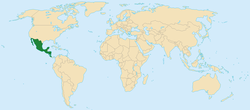Mexican Empire
From Roach Busters
| Imperio Mexicano Mexican Empire | |
| | |
 | 
|
| Flag | Coat of arms |
| | |
| Motto Libertad, unión y religión (Spanish) ("Liberty, union and religion") | |
| | |
| Anthem Himno Nacional Mexicano (Spanish) Mexican National Anthem | |
| | |

| |
| | |
| Capital (and largest city) | Mexico City 19°03′N, 99°22′W |
| | |
| Official language(s) | Spanish |
| | |
| Government - Emperor - President of the Government | Constitutional monarchy Agustín V Adolfo Lora |
| | |
| Legislature - Upper house - Lower house | National Congress Chamber of Senators Chamber of Deputies |
| | |
| State religion | Roman Catholic Church |
| | |
| Independence - Declared - Recognized | from Spain December 16, 1810 September 27, 1821 |
| | |
| Area - Total - Water (%) | 2,395,566 km² 907,968 sq mi 2.51 |
| | |
| Population - July 2009 estimate - Density | 149,611,454 62.45/km² 164.77/sq mi |
| | |
| GDP (PPP) - Total - Per capita | 2009 estimate $5.258 trillion $35,144 |
| | |
| GDP (nominal) - Total - Per capita | 2009 estimate $5.097 trillion $34,071 |
| | |
| Gini (2008) | |
| | |
| HDI (2008) | |
| | |
| Currency | Mexican real (MXN)
|
| | |
| Time zone - Summer (DST) | (UTC -8 to -6) (UTC-7 to -5) |
| | |
| Drives on the | right |
| | |
| Internet TLD | .mx |
| | |
| Calling code | +52 |
The Mexican Empire (Spanish: Imperio Mexicano), commonly known as Mexico, is a federal constitutional monarchy in North America. It is bordered by the United States of America on the north; by Belize and the Caribbean Sea on the east; by the Pacific Ocean on the west; and by Panama and the Pacific Ocean on the south. With an area of 2,395,566 km² and a population just short of 150 million, it is the second-largest Spanish-speaking country by area and the largest by population. Mexico is a federation comprising twenty-two states and one federal district, the capital city.
In Pre-Columbian Mesoamerica many cultures matured into advanced civilizations such as the Olmec, the Toltec, the Teotihuacan, the Maya and the Aztec before the first contact with Europeans. In 1521, Spain created the New Spain which would eventually become Mexico as the colony gained independence in 1821. The post-independence period was characterized by of political unrest and fiscal crisis as well as periods of stability and economic upswing. While its political system has somewhat evolved over time, it has retained a monarchist form of government.
Considered an emerging great power, Mexico is firmly established as a First World country with one of the world's largest and strongest economies, a large and well-educated middle class, very high rankings in most socioeconomic indices. Compared to many other Latin American countries, inequality in wealth and land distribution is relatively low. Mexico today is recognized for its economic freedom, its intense social conservatism (Mexico is among the few countries in which abortion is banned without exception), and its complicated relationship with the United States, with which Mexico has extensive economic ties but an often contentious diplomatic relationship.
